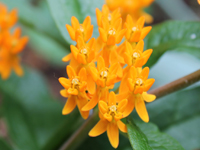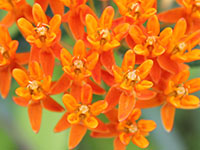![]()
Butterfly Milkweed is a species of milkweed native to eastern North America. It is commonly known as butterfly weed because of the butterflies that are attracted to the plant by its colour and its copious production of nectar. It is also the larval food plant of the Queen and Monarch butterflies. Hummingbirds, bees and other insects are also attracted. The species name "tuberosa" means tuberous, a reference to the large root of the plant.
![]()
There is currently no commercial application for butterfly milkweed. A non-commercial use of butterfly milkweed is to obtain a good quality fibre, which comes from the bark and is used in making twine and cloth. It is easily harvested in late autumn after the plant has died down by simply pulling the fibres off the dried stems. The seed floss is used to stuff pillows or is mixed with other fibres to make cloth. It is a kapok substitute, used in life jackets or as a stuffing material. Very water repellent, the floss has also been used to mop up oil spills at sea. The plant is a potential source of latex, used for making rubber. This species is the only member of the genus that does not have latex in its sap. The seedpods contain an oil and a wax which are of potential importance. Candle wicks are made from the seed floss. The seed contains up to 21% of a semi-drying oil.
![]() Within the realm of naturopathic medicine and folklore, butterfly milkweed has been used to relieve spasms and acts as an expectorant. It was frequently used by North American Natives and acquired a reputation as a heal-all amongst the earlier european settlers. Its main use in present day holistics is for relieving the pain and inflammation of pleurisy. The root is antispasmodic, carminative, mildly cathartic, diaphoretic, diuretic, expectorant, tonic and vasodilator. The root was very popular as a medicinal herb for the treatment of a range of lung diseases, it was considered especially useful as an expectorant. A poultice of the dried, powdered roots is used in the treatment of swellings, bruises, wounds, and ulcers.
Within the realm of naturopathic medicine and folklore, butterfly milkweed has been used to relieve spasms and acts as an expectorant. It was frequently used by North American Natives and acquired a reputation as a heal-all amongst the earlier european settlers. Its main use in present day holistics is for relieving the pain and inflammation of pleurisy. The root is antispasmodic, carminative, mildly cathartic, diaphoretic, diuretic, expectorant, tonic and vasodilator. The root was very popular as a medicinal herb for the treatment of a range of lung diseases, it was considered especially useful as an expectorant. A poultice of the dried, powdered roots is used in the treatment of swellings, bruises, wounds, and ulcers.
Please note that MIROFOSS does not suggest in any way that plants should be used in place of proper medical and psychological care. This information is provided here as a reference only.
![]()
Most parts of butterfly weed have been used as food, some caution is advised since large doses can cause diarrhoea and vomiting due to the slightly toxic nature of the plant. The root of butterfly milkweed has a bitter, nutty-flavour, that when eaten, can increase perspiration. Flower buds, when cooked, taste somewhat like peas. Young shoots, when cooked, can be used as an asparagus substitute. The tips of older shoots are cooked like spinach. The flower clusters can be boiled down to make a sugary syrup. In hot weather the flowers produce so much nectar that it crystallizes out into small lumps which can be eaten like sweets. An edible oil is obtained from the seed, however, the seed are very small and commercial usage would not be very viable.
Please note that MIROFOSS can not take any responsibility for any adverse effects from the consumption of plant species which are found in the wild. This information is provided here as a reference only.
![]()
Butterfly Milkweed is a perennial which prefers to live in dry soil along roadsides and in fields. Suitable for: light (sandy) and medium (loamy) soils and prefers well-drained soil. Suitable pH: acid, neutral and basic (alkaline) soils. It can grow in semi-shade (light woodland) or no shade.
| Soil Conditions | |
| Soil Moisture | |
| Sunlight | |
| Notes: |
![]()
Butterfly Milkweed grows from 30cm to 75cm tall, with clustered orange or yellow flowers from early summer to early autumn. The leaves are linear and approximately 5cm to 15cm long, alternately arranged, along the central stalk of the plant. THe flowers are orange and 70mm to 100mm long with the petals and sepals bent backward, exposing the corona. The corona contains 5 yellowish orange hoods, each 5mm to 7mm long. These flowers grow in an umbel 7cm to 9cm across which contain 20 to 40 of the flowers. When butterfly milkweed goes to seed; an 8cm to 12cm long pod appears on the top of the plant and contains the seeds.
![]()
| Plant Height | 30cm to 75cm | 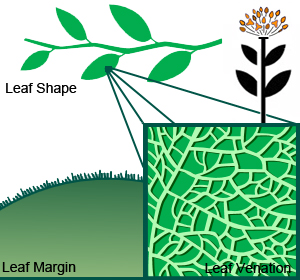 |
| Habitat | Dry open soil, Roadsides, Fields | |
| Leaves | Linear, Alternate leaves 5cm to 15cm long | |
| Leaf Margin | Clinate | |
| Leaf Venation | Reticulate | |
| Stems | Hairy Stem | |
| Flowering Season | June to September | |
| Flower Type | Rounded Clusters | |
| Flower Colour | Orange | |
| Pollination | Bees, Insects | |
| Flower Gender | flowers are hermaphrodite (have both male and female organs) | |
| Fruit | Seeds contained in a hairy pod 75mm to 120mm long | |
| USDA Zone | 4A (-31°C to -34°C) cold weather limit |
![]()
The following health hazards should be noted when handling or choosing a location to plant butterfly milkweed:
 |
TOXIC Butterfly Milkweed is toxic if eaten in large quantities. |
![]()
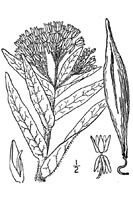 |
-Click here- or on the thumbnail image to see an artist rendering, from The United States Department of Agriculture, of butterfly milkweed. (This image will open in a new browser tab) |
![]()
 |
-Click here- or on the thumbnail image to see a magnified view, from The United States Department of Agriculture, of the seeds created by butterfly milkweed for propagation. (This image will open in a new browser tab) |
![]()
Butterfly Milkweed can be referenced in certain current and historical texts under the following three names:
Butterfly Milkweed can be translated into the following select languages:
| Arabic | افراشة حشيشة اللبن | Bulgarian | Chinese (Sim) | 蝴蝶乳草 | |
| Croatian | Leptir mlječika | Czech | Danish | ||
| Dutch | Esperanto | Estonian | |||
| Finnish | French | papillon asclépiade | German | ||
| Greek | Hebrew | פרפר פרח חלבלוב | Hungarian | ||
| Italian | Japanese | バタフライトウワタ | Korean | 나비 유 | |
| Punjabi | Lithuanian | Norwegian | |||
| Persian | پروانه استبرق | Polish | Portuguese | ||
| Romanian | Russian | Бабочка Милкуид | Slovak | ||
| Spanish | mariposa algodoncillo | Swedish | Tagalog | ||
| Turkish | Ukrainian | метелик Мілкуід | Vietnamese | Cây bông tai bướm |
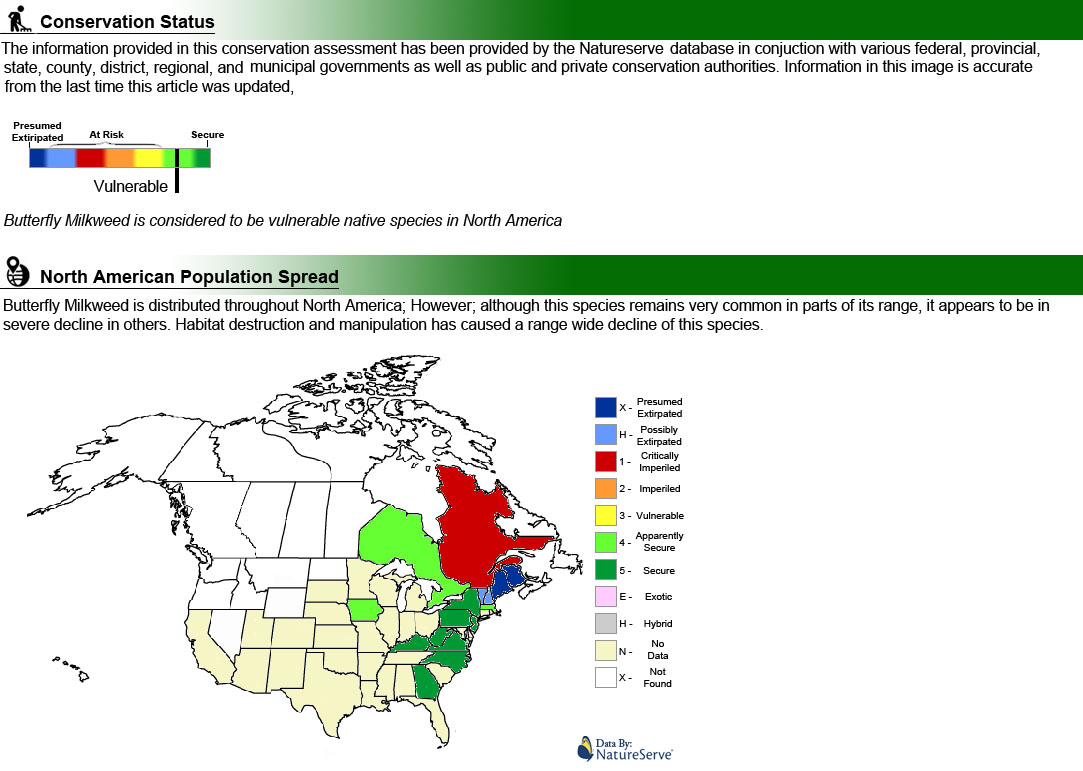
![]()
 |
The MIROFOSS database offers free printable garden tags for personal and non-profit use. These tags can be used to properly identify plant samples in a garden. Click on the tags shown on the the screen or -click here- to download a full size jpeg image for a butterfly milkweed identification tag; which can be printed on paper or used with a plastic laser printer. |
 |
What's this? What can I do with it? |
![]()
| Description | Cronquist, A., A.H. Holmgren, N.H. Holmgren, J.L. Reveal, and P.K. Holmgren. 1984. Intermountain Flora: Vascular Plants of the Intermountain West, U.S.A. Vol. 4, Subclass Asteridae (except Asteraceae). New York Botanical Garden, Bronx. 573 pp. |
| Description | Kartesz, J.T. 1994. A synonymized checklist of the vascular flora of the United States, Canada, and Greenland. 2nd edition. 2 vols. Timber Press, Portland, OR. |
| Biology | Swink, F., and G. Wilhelm. 1994. Plants of the Chicago Region. Morton Arboretum. Lisle, Illinois. |
| Holistics | Peterson, L.A. 1977. A Field Guide to Edible Wild Plants, Eastern/Central North America. Houghton Mifflin Company, Boston. 330 pp. |
| Biology | Dickinson, T.; Metsger, D.; Bull, J.; & Dickinson, R. (2004) ROM Field Guide to Wildflowers of Ontario. Toronto:Royal Ontario Museum, |
| Image Rendering | USDA-NRCS PLANTS Database / USDA NRCS. Wetland flora: Field office illustrated guide to plant species. USDA Natural Resources Conservation Service. |
| Environment | National Audubon Society. Field Guide To Wildflowers (Eastern Region): Alfred A. Knopf. ISBN 0-375-40232-2 |
| Physical Identification | National Audubon Society. Field Guide To Wildflowers (Eastern Region): Alfred A. Knopf. ISBN 0-375-40232-2 |
| September 08, 2016 | The last time this page was updated |
| ©2025 MIROFOSS™ Foundation | |
 |
|

